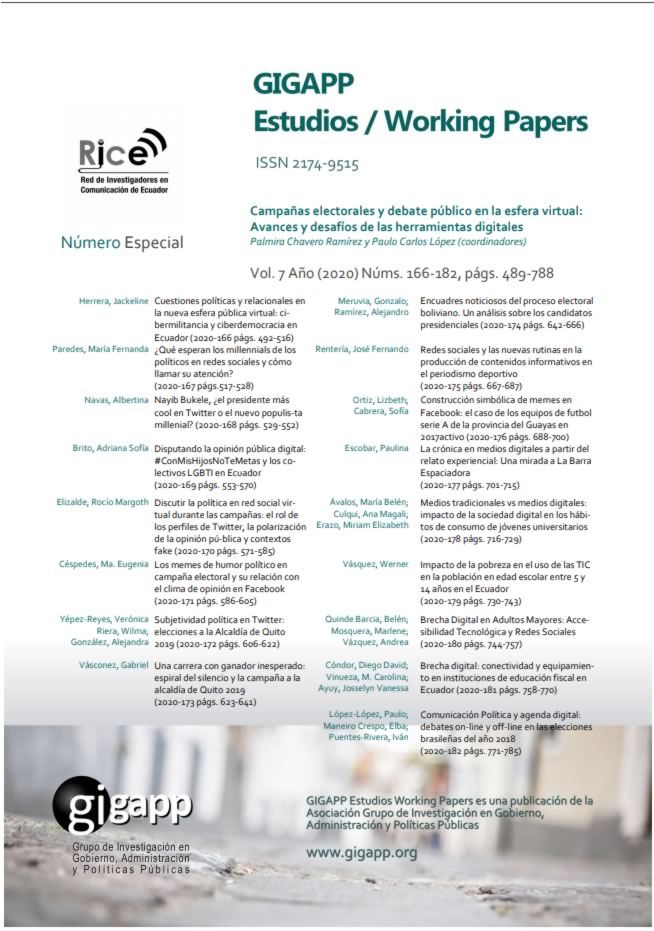Nayib Bukele, ¿el presidente más cool en Twitter o el nuevo populista millenial?
Resumen
Nayib Bukele, el político más joven (37 años) en asumir la Presidencia de El Salvador, se autoproclamó en Twitter “el presidente más cool del mundo”, seis días después de su posesión, en junio de 2019. Tan pronto inició su gestión, desató una conmoción en las redes sociales por su forma desenfadada de dirigirse a su audiencia. Esta estrategia le ha generado atención y popularidad. Varias veces se ha convertido en trending topic y, durante sus primeros siete días de gobierno, consiguió 90 000 nuevos seguidores, acercándolo al primer millón. Sin embargo, su actitud en redes no siempre es conciliadora y se empieza a hablar de un populismo millenial. El presente trabajo analiza el comportamiento de la cuenta @nayibbukele, desde una óptica comunicacional, a través de un modelo de 16 indicadores y 70 subindicadores, correspondientes a las dimesiones clásicas de un estudio de Comunicación: quién (Actividad), dice qué (Contenido), a quién (Conversación y Popularidad), en qué canal (Twitter) y con qué efectos (Influencia).
Descargas
Citas
Arditi, B. (2010). Arguments about the left: A post-liberal politics? In C. A. Maxwell & E.
Block, E., y Negrine, R. (2017). The populist communication style: Toward a critical framework. Interna-tional Journal of Communication, 11(20). Recuperado de http://ijoc.org/index.php/ijoc/article/view/5820
Bos, L., y Brants, K. (2014). Populist rhetoric in politics and media: A longitudinal study of the Nether-lands. European Journal of Communication, 29(6), pp. 703–719.
Burson-Marsteller. (2017). Twiplomacy. Recuperado de http://twiplomacy.com/blog/twiplomacy-study-2017/.
Caldevilla, D. (2009). Democracia 2.0: La política se introduce en las redes sociales. Pensar La Publicidad, 3, 31–48.
Castells, M. (2009). Comunicación y Poder. Madrid, España: Alianza Editorial.
Coronel, G. y Mier, A. (2011). Impacto de Twitter en Ecuador, Caso 30S. Trabajo presentado en Memoria 2011 Conferencia Iberoamericana en Sistemas, Cibernética e Informática: CISCI 2011. Loja, Ecua-dor. Recuperado de http://www.iiis.org/CDs2011/CD2011CSC/CISCI_2011/PapersPdf/CA806GT.pdf.
De la Torre, C. (Ed.). (2015). The promise and perils of populism: Global perspectives. Lexington, KY: Uni-versity of Kentucky Press.
Deacon, D., y Wring, D. (2016). The UK Independence Party, populism and the British news media: Com-petition, collaboration or containment? European Journal of Communication, 31(2), pp. 169–184.
Deltell, L., Congosto, M., Claes, F. y Osteso, J. (2013). Identificación y análisis de los líderes de opinión en Twitter en torno a Hugo Chávez. Revista Latina de Comunicación Social, 13(68), 696–718, https://doi.org/10.4185/RLCS-2013-997.
El Hamdouni, Y. (2013). Internet y la primavera árabe: hacia una nueva percepción del ciberespacio. Paix et Sécurité Internationales: Revue Maroco-Espagnole de Droit International et Relations Internatio-nales, (1), 167–173.
Engesser, S., Ernst, N., Esser, F., y Büchel, F. (2016). Populism and social media: How politicians spread a fragmented ideology. Information, Communication & Society, 20(8), pp. 1109–1126.
Enli, G. (2017). Twitter as arena for the authentic outsider: Exploring the social media campaigns of Trump and Clinton in the 2016 US presidential election. European Journal of Communication, 32(1), pp. 50–61.
Fuchs, C. y Sandoval, M. (2014). Introduction: Critique, Social Media and the Information Society in the Age of Capitalist Crisis. En Critique, Social Media and the Information Society (1 - 47). Inglaterra: Routledge, https://doi.org/10.4324/9780203764077.
Fumero y Rodríguez. (2006). Más allá de la Administración Electrónica, hacia un Gobierno de Nueva Ge-neración. Gobernanza 2.0. Análisis local, 67(IV), 5 - 18.
García Jurado, R. (2012). Sobre el concepto de populismo. Estudios 103 (10), pp. 7-32.
Girón, G. y Marroquín, M. (2019). #UnaCampañaQueHizoHistoria. En W. Carballo. (Ed.), Nuevos e-scenarios comunicación digital. Investigaciones sobre comunicación digital en El Salvador, 3, 243 (pp. 13-61). Recuperado de http://monicaherrera.edu.sv/investigacion-docs/investigacion-institucional/Monica-Herrera-Investigacion-Nuevos-Escenarios-Comunicacion-Digi-tal.pdf.pdf?fbclid=IwAR1bk2beY3naPURRRM38Bwhwnv3dbh39x2eI3pNgRfjS_CpIDVbzx44YqcM
Gladwell, M. (2011). A small change: Why the revolution will not be tweeted. Revista De Occidente, (362–363), 139–154.
Gutiérrez-Rubí, A. (2014). Tecnopolítica. El uso y la concepción de las nuevas herramientas tecnológicas para la comunicación, la organización y la acción política colectivas. Barcelona, España: Grafiko.
Gutíérrez-Rubí, A. (2016) Telefónica. Millennials en Latinoamérica. Una perspectiva desde Ecuador. Bar-celona, Españla: Ariel. Recuperado de https://fundaciontelefonica.com.ec/millennialsec/?fbclid=IwAR0vZA2j4Yte0Bih2j1wVE5dhjwR0d017OawRy4S0c7wnmFUUJff92J8nJo
Habermas, J. (1994). Historia y crítica de la opinión pública: la transformación estructural de la vida públi-ca. Barcelona, España: Gustavo Gili.Hameleers, M., & Schmuck, D. (2017). It’s us against them: A comparative experiment on the effects of populist messages communicated via social media. In-formation, Communication & Society, 20(9), pp. 1425–1444.
Hershberg (Eds.). Latin America’s left turn: Politics, policies, and trajectories of change. (pp. 145–170). Boulder, CO: Lynne Rienner Publishers.
Jones, V. (2017). Trump: The Social Media President? Recuperado de http://edition.cnn.com/2015/10/26/opinions/jones-trump-social-media/index.html
Kellner, D. (2017). American nightmare: Donald Trump, media spectacle, and authoritarian populism. Rot-terdam: Sense Publishers.
Krämer, B. (2017). Populist online practices: the function of the Internet in right-wing populism. Infor-mation, Communication & Society, 20(9), pp. 1293-1309.
Laclau, E. (2005). Populism: What’s in a Name. Populism and the Mirror of Democracy, 48.
Lasswell, H. (1948). The structure and function of communication in society. En L. Bryson, (ed.) The Communication of Ideas, (pp.37–52). New York, New York, Estados Unidos Recuperado de http://www.dhpescu.org/media/elip/The structure and function of.pdf
Lee, K. (2014). The Social Media Frequency Guide: How Often To Post To Facebook, Twitter, LinkedIn, And More. Recuperado de https://www.fastcompany.com/3029019/the-social- media-frequency-guide-how-often-to-post-to-facebook-twitter-linkedin-a.
Llorente y Cuenca. (2014). Análisis de las dimensiones reputacionales de los presidentes de latinoaméri-ca. Recuperado de https://www.developing-ideas.com/wpcontent/uploads/sites/6/2016/01/140331_dmasi_Estudio_Presidentes_Latam.pdf.
Márquez, I. (2017). ¿Existe una esfera pública digital? Una reflexión crítica. En A. Navas (Comp.), Redes sociales, ciudadanía y política. Claves de la nueva esfera pública (pp. 127- 142). Guatemala: Grafía Etc. Recuperado de https://www.albertinanavas.com/publicaciones.
Mazzoleni, G. (2008). Populism and the media. In D. Albertazzi & D. McDonnell (Eds.),
Moffitt, B. (2016). The global rise of populism: Performance, political style, and representation. Stanford University Press.
Moffitt, B. (2019). The Global Rise of Populism: Performance, Political Style, and Representation.
Morozov, E. (2012). El desengaño de Internet: los mitos de la libertad en la red. Barcelona, España: Desti-no.
Müller, J. W. (2014). The people must be extracted from within the people: Reflections on Populism. Constellations, 21(4), pp. 483–493.
Navas, A. (Comp.). (2017) Redes sociales, ciudadanía y política. Claves de la nueva esfera pública. Guate-mala: Grafía Etc. Recuperado de https://www.albertinanavas.com/publicaciones.
Navas, A. (2018). Modelo de variables de desempeño e impacto en Twitter. Un análisis comunicacional (tesis doctoral). Universidad de Navarra, Pamplona, España. Recuperado de https://www.academia.edu/38034265/11Tesis_global_nov2018_AN.pdf .
Nielsen, J. (2006). The 90-9-1 Rule for Participation Inequality in Social Media and Online Communities. Recuperado de https://www.nngroup.com/articles/participation-inequality/.
Orihuela, J. (2012). Mundo Twitter: una guía para comprender y dominar la plataforma que cambió la red. Barcelona, España: Alienta Editorial.
Ortiz Leroux, S. (2006). Deliberando sobre la democracia deliberativa. Los dilemas de la deliberación pú-blica. Acta Republicana, Política y Sociedad, (5), 53–64.
Ricaurte. C. (2017). Capítulo II: Tuitómetro, la batalla en 140 caracteres. En. A. Navas. Comp.). Redes so-ciales, ciudadanía y política. Claves de la nueva esfera pública. Guatemala: Grafía Etc. Recuperado de https://www.albertinanavas.com/publicaciones.
Schneider, P. (2011). Is the 90-9-1 Rule for Online Community Engagement Dead? Recuperado de http://blog.socious.com/bid/40350/Is-the-90-9-1-Rule-for-Online-Community-Engagement-Dead-Data.
Subirats, J. (2011). Otra sociedad, ¿otra política?: De “no nos representan” a la democracia común. Barce-lona, España: Icaria Editorial. Recuperado de https://doi.org/10.1017/CBO9781107415324.004.
Tascón, M. y Quintana, Y. (2012). Ciberactivismo: las nuevas revoluciones de las mulititudes conectadas (277–279). Madrid, España: Los libros de La Catarata.
Thompson, J. B. (2011). Los límites cambiantes de la vida pública y la privada. Comunicación y Sociedad, (15), 11–42.
Waisbord, S. (2013). Media policies and the blindspots of media globalization: Insights from Latin Ameri-ca. Media, Culture and Society, 35(1), 132–138, https://doi.org/10.1177/0163443712464567
Waisbord, S. (2018). Why populism is troubling for democratic communication. Communication Culture & Critique, 11(1), 21-34
Whittingham, T. (2014). Social Politics. Sidney, Australia: Learning with Media.
Wilson, J. (2011). Playing with politics: Political fans and Twitter faking in post-broadcast democracy. Convergence, 17(4), 445–461. Recuperado de https://doi.org/10.1177/1354856511414348
Wong, J. (6 de junio de 2016). El presidente MAS COOL del mundo. YouTube. Recuperado de https://www.youtube.com/watch?v=uqe7vrs82Xs&t=16s.
Derechos de autor 2020 Albertina Navas, Dra. (Autor/a)

Esta obra está bajo licencia internacional Creative Commons Reconocimiento-NoComercial-CompartirIgual 4.0.
Aquellos autores/as que tengan publicaciones con esta revista, aceptan los términos siguientes:
a. Los autores/as conservarán sus derechos de autor y garantizarán a la revista el derecho de primera publicación de su obra, el cuál estará simultáneamente sujeto a la Licencia de reconocimiento de Creative Commons Attribution-NonCommercial-ShareAlike 4.0 International (CC BY-NC-SA 4.0) que permite a terceros compartir la obra siempre que se indique su autor y su primera publicación esta revista.
Con esta licencia de acceso abierto, los lectores (usuarios) pueden:
- Compartir — copiar y redistribuir el material en cualquier medio o formato
- Adaptar — remezclar, transformar y construir a partir del material
Bajo los siguientes términos:
-
Atribución — usarios deberán dar crédito de manera adecuada, brindar un enlace a la licencia, e indicar si se han realizado cambios. Puede hacerlo en cualquier forma razonable, pero no de forma tal que sugiera que usted o su uso tienen el apoyo de la licenciante.
-
NoComercial — usuarios no puede hacer uso del material con propósitos comerciales.
-
CompartirIgual — Si remezcla, transforma o crea a partir del material, usuarios deben distribuir su contribución bajo la misma licencia del original.
-
Sin restricciones adicionales: los usuarios no pueden aplicar términos legales o medidas tecnológicas que restrinjan legalmente a otros de hacer cualquier cosa que permita la licencia.
b. Los autores/as podrán adoptar otros acuerdos de licencia no exclusiva de distribución de la versión de la obra publicada (p. ej.: depositarla en un archivo telemático institucional o publicarla en un volumen monográfico) siempre que se indique la publicación inicial en esta revista
c. Se permite y recomienda a los autores/as difundir su obra a través de Internet (p. ej.: en archivos telemáticos institucionales o en su página web) antes y durante el proceso de envío, lo cual puede producir intercambios interesantes y aumentar las citas de la obra publicada. (Véase El efecto del acceso abierto).



